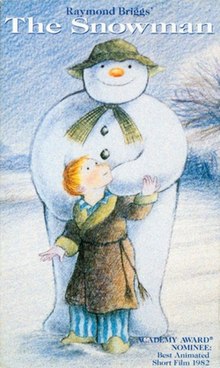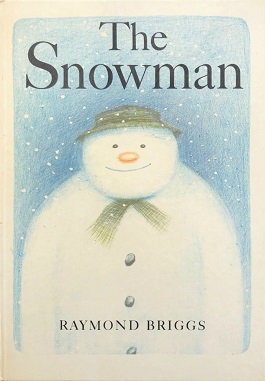The Snowman
- This article is about the book (1978) and its film adaptation (1982). For other uses, see Snowman (disambiguation).
| The Snowman (film) | |
|---|---|
 | |
| Directed by | Dianne Jackson |
| Written by | Raymond Briggs (book) |
| Produced by | John Coates |
| Music by | Howard Blake (composer) Peter Auty (treble) Sinfonia of London |
| Distributed by | Channel 4, Universal Pictures (UK) Columbia TriStar Entertainment (USA) |
Release dates | 26 December 1982 (original) 29 December 1983 (David Bowie) 24 December 2002 (Mel Smith) |
Running time | 27 min. |
| Language | English |
The Snowman is a children's book without words by English author Raymond Briggs, first published in 1978 by Hamish Hamilton in the U.K., and published by Random House in the U.S. that November. In Britain it was highly commended runner up for the Kate Greenaway Medal from the Library Association, recognising the year's best children's book illustration by a British subject.[1][a] In the U.S. it was named to the Lewis Carroll Shelf Award list in 1979.
The Snowman was adapted as a 26-minute animated film by Dianne Jackson for the fledgling British public-service Channel 4. It was first telecast late on Christmas Eve in 1982 and was an immediate success. It was nominated for the 1982 Academy Award for Animated Short Film and it has been shown every year, becoming part of British and international popular culture at Christmas.
The film story is told through pictures, action and music, scored by Howard Blake. It is wordless like the book, except for the song "Walking in the Air". In addition to the orchestral score, performed in the film by the Sinfonia of London, Blake composed the music and lyrics of the song, performed by a St Paul's Cathedral choirboy Peter Auty.
The film ranks 71 on the 100 Greatest British Television Programmes, a year 2000 list drawn up by the British Film Institute, based on a vote by industry professionals. It was voted number 4 in UKTV Gold's Greatest TV Christmas Moments.
Plot of the film
The Snowman is the tale of a boy who builds a snowman one winter's day. That night, at the stroke of twelve, the snowman comes to life. The first part of the story deals with the snowman's attempts to understand the appliances, toys and other bric-a-brac in the boy's house, all while keeping quiet enough not to wake the boy's parents. The two then venture back outside and go for a ride on a motorcycle, disturbing many animals: pheasants, rabbits, a barn owl, a fox and a brown horse.
In the second part of the story, the boy and the snowman take flight — the song "Walking in the Air" appears at this point. They fly over the boy's town, over houses and large public buildings before flying past the Royal Pavilion in Brighton and West Pier and then out into the ocean. They continue through an arctic landscape and fly past many sights and animals such as penguins. Flying into the aurora they reach their destination.
The two wander hand-in-hand into a snow-covered forest and attend a snowmen's party, at which the boy is the only human. They meet Father Christmas and his reindeer, and the boy is given a scarf with a snowman pattern.
The story ends after the return journey. However, the sun has come out the next morning and the boy wakes up to find the snowman has melted. The boy begins to wonder if the night's events were all a dream, but he discovers that he still has the snowman scarf given to him by Father Christmas. Realising the night's events were real, as the credits play, the boy mourns the loss of his friend.
Plot of the book
 Briggs' illustration of the snowman | |
| Author | (no words) |
|---|---|
| Illustrator | Raymond Briggs |
| Genre | Picture book |
| Publisher | Hamish Hamilton |
Publication date | 1978 |
| Publication place | United Kingdom |
| Media type | |
| Pages | 30 pp |
The original book has a slightly different plot. While the first half of the story remains the same, the boy and the snowman do not visit Father Christmas. In fact, all of the Christmas elements of the film were not present in the story. Notably, the boy's family does not have a Christmas tree in the house. After the snowman comes to life, they proceed to explore the boy's house. After they see the family car and play with the lights, the boy prepares a feast that the two eat by candlelight. Here the snowman takes the boy outside again, and they begin to fly. Once the boy and the snowman take flight, they only fly as far as the pier seen in the film. They stop there and wait for the sunrise. They hurry back, as the sun is rising, and the boy hurries inside again, like the film. The finale does not show James finding the scarf in his pocket, as they never made the trip to Father Christmas, but he finds the snowman melted in the same fashion.
Alternative beginnings
After the initial showing on Channel 4, and in its initial showings on U.S. television, an alternative introduction was sometimes used. Instead of Raymond Briggs describing how much it had snowed the winter he made The Snowman, while walking through the field that morphed into the animation of the same landscape, David Bowie was shown reciting the same speech after walking into the attic of 'his' childhood home and discovering a scarf in a drawer. This scarf closely resembles the one given to the boy towards the end of the film. The Universal DVD The Snowman & Father Christmas (902 030 - 11), released in the UK in 2000, uses the Bowie opening. (The Bowie intro is actually missing on some Sony DVDs, despite being featured on the packaging.)[2]
To celebrate the film's 20th anniversary, Channel 4 used an alternate opening directed by Roger Mainwood, with Raymond Briggs' interpretation of Father Christmas recounting how he met the boy. Father Christmas is voiced by comedian Mel Smith. Channel 4 have used this opening since 2002. This version is also cropped to 16:9 widescreen.
Production notes
The song "Walking in the Air" is sung in the film by chorister Peter Auty,[3] who was not credited in the original version. He was given a credit on the 20th anniversary version. The song was covered several years later by Welsh chorister Aled Jones in a single which reached number 5 in the UK charts. Jones is sometimes incorrectly credited with having sung the song in the film.[4]
Though the boy in the book is unnamed, in the film he is named "James". This is clear on the tag for the present he receives from Father Christmas. The name was added by Joanna Harrison, one of the animators, as it was her boyfriend's (later her husband) name.[5] Additionally, Raymond Briggs' version of Father Christmas mentions the boy's name in the 20th anniversary opening.
In the film, the boy's home seems to be in the South Downs of England, near to Brighton; he and Snowman fly over what appears to be Brighton; the Royal Pavilion and Palace Pier are clearly depicted. Later in the film, the tag on his present confirms this.
The film was produced using traditional animation techniques, consisting of pastels, crayons and other colouring tools drawn on pieces of celluloid, which were traced over hand drawn frames. For continuity purposes, the background artwork was painted using the same tools.
Stage version
The Snowman has also been made into a stage show. It was first produced by Contact Theatre, Manchester in 1986.[6] The Contact Theatre production was adapted and produced by Anthony Clark. It had a full script and used Howard Blake's music and lyrics. In 1993, Birmingham Repertory Company produced a version, with music and lyrics by Howard Blake, scenario by Blake, with Bill Alexander and choreography by Robert North. Since 1997 Sadler's Wells has presented it every year as the Christmas Show at the Peacock Theatre. As in the book and the film, there are no words, apart from the lyrics of the song "Walking in the Air". The story is told through images and movement. Special effects include the Snowman and boy flying high over the stage (with assistance of wires and harnesses) and ‘snow’ falling in part of the auditorium. The production has had several revisions – the most extensive happening in 2000, when major changes were made to the second act, introducing new characters: The Ice Princess and Jack Frost.
New version
A 23-minute new version titled The Snowman 2 will air on Christmas 2012 on Channel 4 to celebrate 30th anniversary of the original short and Channel 4. Produced at the London based animation company Lupus Films, with many of the original team returning, the sequel will be made in the same traditional techniques as the first film, and it will feature the Snowman, a new little boy, and a snow dog, flying over international landmarks.[7]
See also
- Granpa, Dianne Jackson's second animated film for Channel 4, with music by Howard Blake.
- Father Christmas – Briggs' earlier two works Father Christmas and Father Christmas Goes on Holiday were combined into a film which was released in 1991. It features an altered version of the snowmen's party at the North Pole from this film. The young boy and the snowman from this film are seen in the background during this segment.
- The Bear - another book by Raymond Briggs which was also adapted into a 26-minute animated version.
Notes
- ^ According to CCSU, some runners up for the Greenaway Medal through 2002 were Commended (from 1959) or Highly Commended (from 1974). There were 31 "Highly Commended" runners up in 29 years from 1974 to 2002, including Briggs alone in 1978.
References
- ^ "Kate Greenaway Medal". 2007(?). Curriculum Lab. Elihu Burritt Library. Central Connecticut State University (CCSU). Retrieved 2012-07-18.
- ^ "Customer Discussions: Review Comment Thread". Amazon.com. Amazon.com. November 2006. Retrieved 24 May 2008.
- ^ Interviews with Peter Auty, Aled Jones, Raymond Briggs and John Coates on the making of documentary titled "Snow Business" included on the 2004 20th Anniversary DVD
- ^ For example: Barclay, Ali (04 December 2000). "The Snowman (1982)". BBC – Films. BBC. Retrieved 2008-05-24.
{{cite web}}: Check date values in:|date=(help) - ^ Interview with Hilary Andus and Joanna Harrison on the making of documentary titled "Snow Business" included on the 2004 20th Anniversary DVD
- ^ http://www.citylife.co.uk/theatre_dance/reviews/10748_the_snowman___the_lowry mentioned in review.
- ^ Brown, Maggie (22 December 2011). "New version of The Snowman to be screened on Channel 4 next year". The Guardian. Retrieved 24 April 2012.
